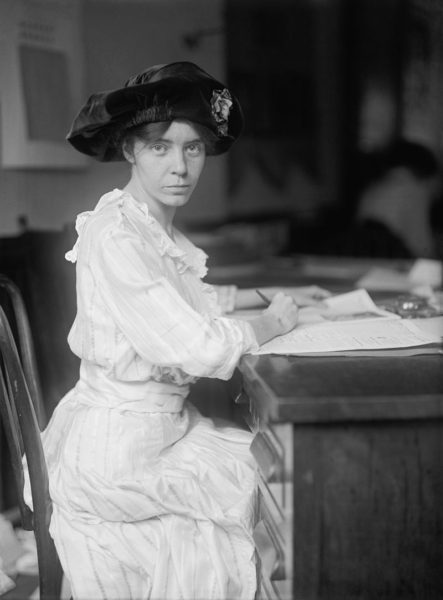 Last updated: March 15, 2024
Last updated: March 15, 2024
August 26, 2020 was Women’s Equality Day, a celebration of the centennial anniversary of the 1920 ratification of the Nineteenth Amendment to the Constitution that guarantees that, “The right of citizens of the United States to vote shall not be denied or abridged by the United States or by any State on account of sex.” This is part two of a four-part series, describing the many years of exhaustive effort channelled by American women into the suffrage movement that ultimately secured voting rights for women nationally.
Going into the turn of the twentieth century, American women had been granted voting rights in only four western territories and states: Wyoming (1869,) Utah (1870,) Colorado (1893,) and Idaho (1896.) Despite countless protests and the exhaustive efforts of Susan B. Anthony, Elizabeth Cady Stanton and other dedicated women for over five decades, the first wave of the women’s movement had not achieved their goals for expanding the rights of women, including suffrage.
Alice Paul (1885-1977,) one of the most important suffragists in the early twentieth century, was raised in a Quaker household. She moved to England in 1907 to study economics and sociology and became deeply involved with the British women’s suffrage movement. She learned the basics of activism and social disobedience from feminist Emmeline Pankhurst (1858-1928) and was arrested seven times. As she continued to speak out and demonstrate, she was imprisoned three times. Due to her deterioration from hunger strikes, she was released early from her first two prison terms and was force fed during the third.
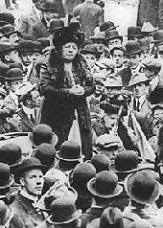 Another prominent feminist at the time was Harriot Stanton Blatch (1856-1940.) She was the daughter of Elizabeth Cady Stanton and spent many years in England where she also learned the tactics of the militant wing of the British suffrage movement, as they developed. In 1907, after returning to the United States, she founded the Equality League of Self-Supporting Women, later called the Women’s Political Union. This organization targeted working women, particularly working class women, for membership. She also introduced the practice of holding suffrage parades, such as the one held in 1910 in New York. She was unique because she organized open air rallies and militant street protests, while at the same time participating in savvy backroom politics and working in partnership with society women.
Another prominent feminist at the time was Harriot Stanton Blatch (1856-1940.) She was the daughter of Elizabeth Cady Stanton and spent many years in England where she also learned the tactics of the militant wing of the British suffrage movement, as they developed. In 1907, after returning to the United States, she founded the Equality League of Self-Supporting Women, later called the Women’s Political Union. This organization targeted working women, particularly working class women, for membership. She also introduced the practice of holding suffrage parades, such as the one held in 1910 in New York. She was unique because she organized open air rallies and militant street protests, while at the same time participating in savvy backroom politics and working in partnership with society women.
In 1910, Alice Paul moved back to the United States and obtained a PhD in sociology from the University of Pennsylvania. In 1912, she and Lucy Burns (1879-1966,) who was an American suffragist she had met and protested with in England, became members of the National American Womens Suffrage Association (NAWSA.) At that time, many 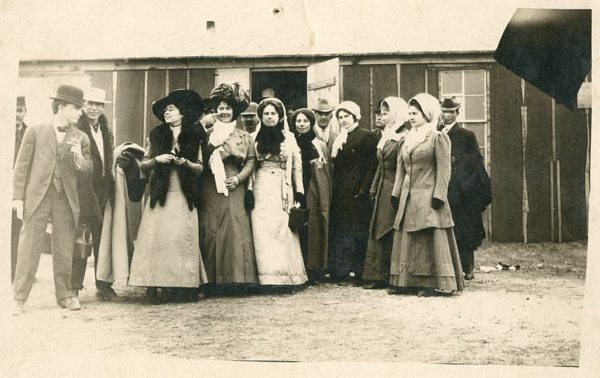 women across the country became interested and involved in the suffrage movement, including these women in Houston at right, who were photographed in 1912.
women across the country became interested and involved in the suffrage movement, including these women in Houston at right, who were photographed in 1912.
The NAWSA organization at the time was led by Anna Shaw (1847-1919) who was both a physician and a preacher. Without any financial support from her family, she was the only woman in her 1876 class at the Boston University School of Theology. After being ordained as a minister in the Methodist Protestant Church, she also graduated as a physician from Boston University in 1886. It was during her medical studies that Shaw became vocal about advocating for women’s rights. Influenced by Susan B. Anthony, she joined the National Womens Suffrage Association (NWSA)  and actively participated in their 1890 merger with the American Women’s Suffrage Association (AWSA.) In 1904, she replaced Carrie Chapman Catt as NAWSA president, when Catt needed to take a leave of absence to care for her dying husband. At its height, the NAWSA had around 2 million members.
and actively participated in their 1890 merger with the American Women’s Suffrage Association (AWSA.) In 1904, she replaced Carrie Chapman Catt as NAWSA president, when Catt needed to take a leave of absence to care for her dying husband. At its height, the NAWSA had around 2 million members.
Alice Paul became very active with the NAWSA and led the Congressional Committee, which was an auxiliary organization. In March 1913, she and Lucy Burns organized an audacious parade down Pennsylvania Avenue in Washington D.C. The official program indicated that the purpose was to “march in a spirit of protest against the present political organization of society, from which women are excluded.” They purposely scheduled it for the day before Woodrow Wilson’s inaugural parade, in order to maximize publicity and to attempt to influence Wilson to support votes for women.
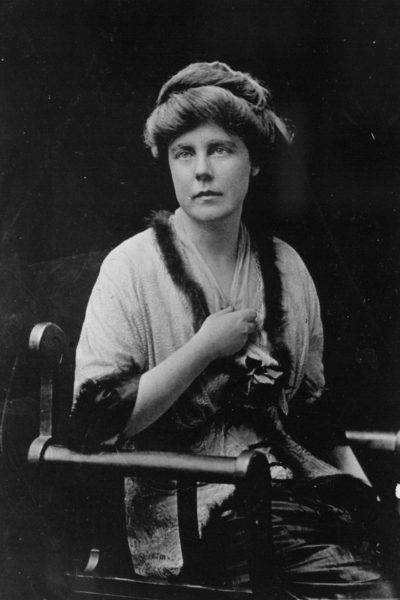 According to The New York Times, the procession was “one of the most impressively beautiful spectacles ever staged in this country.” There were bands and floats, and somewhere between 5,000 and 10,000 marchers from across the nation. One of the sections near the front of the parade included women from Norway, Finland, Australia and New Zealand, four countries where women already were enfranchised. The procession was led by legendary labor lawyer, Inez Milholland (1886-1916,) dressed in white and mounted on horseback.
According to The New York Times, the procession was “one of the most impressively beautiful spectacles ever staged in this country.” There were bands and floats, and somewhere between 5,000 and 10,000 marchers from across the nation. One of the sections near the front of the parade included women from Norway, Finland, Australia and New Zealand, four countries where women already were enfranchised. The procession was led by legendary labor lawyer, Inez Milholland (1886-1916,) dressed in white and mounted on horseback.
However, no matter the organization or beauty, in the end the marchers were greeted by men who shouted insults and obscenities at them. The women were also assaulted physically, while police looked on and did nothing to intervene against the crowd’s behavior that resulted in the injury of nearly 200 women. It would likely have been considerably worse without the assistance of the Massachusetts National Guard, the Pennsylvania National Guard, and some Maryland Agricultural College students, who created a human shield to protect the women and to allow them to continue with their procession.
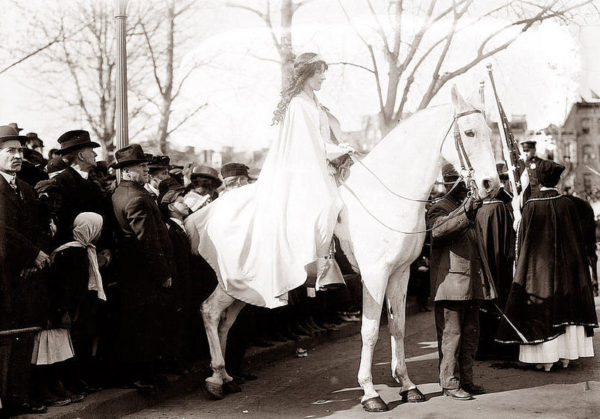 Around 50 African American women participated in the 1913 parade. Although not opposed to suffrage for African American women, the parade organizers asked blacks to march at the end of the procession, in order not to antagonzie Southern Democrats. Mary Church Terrell (1863-1954) complied, but Ida B. Wells (1862-1931,) shown below at right, refused to march at the rear. She waited in the crowd for the parade to begin and then joined the all-white delegation from Illinois as they passed by. The NAACP newspaper, The Crisis, reported that another forty black women also marched with their state delegations or with delegrations of women who shared their professions and/or academic backgrounds.
Around 50 African American women participated in the 1913 parade. Although not opposed to suffrage for African American women, the parade organizers asked blacks to march at the end of the procession, in order not to antagonzie Southern Democrats. Mary Church Terrell (1863-1954) complied, but Ida B. Wells (1862-1931,) shown below at right, refused to march at the rear. She waited in the crowd for the parade to begin and then joined the all-white delegation from Illinois as they passed by. The NAACP newspaper, The Crisis, reported that another forty black women also marched with their state delegations or with delegrations of women who shared their professions and/or academic backgrounds.
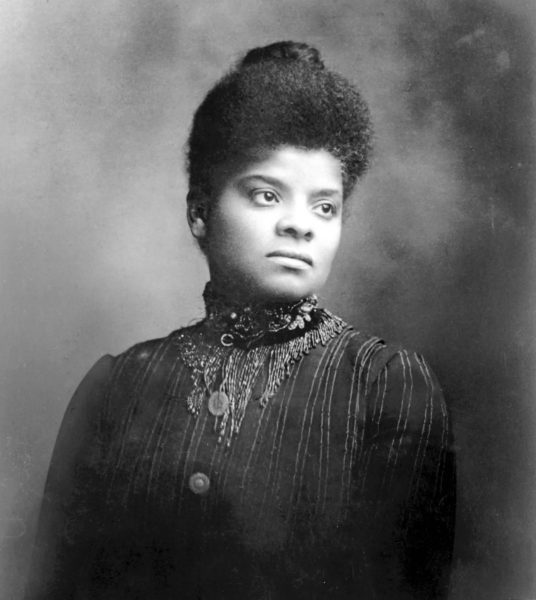 Native American, Marie Louise Bottineau Baldwin (1863-1952), of the Turtle Mountain Chippewa tribe, shown below and to the left, was a nationally recognized spokesperson for indigenous women’s rights and suffrage over the course of her lifetime. In the 1890s, Baldwin and her father moved to Washington, D.C., where she was appointed by Theodore Roosevelt to be a clerk in the Office of Indian Affairs in 1904. She was the first woman of color to graduate from the Washington College of Law and marched under the banner of women lawyers in the 1913 Women’s Suffrage Parade in Washington, D.C.
Native American, Marie Louise Bottineau Baldwin (1863-1952), of the Turtle Mountain Chippewa tribe, shown below and to the left, was a nationally recognized spokesperson for indigenous women’s rights and suffrage over the course of her lifetime. In the 1890s, Baldwin and her father moved to Washington, D.C., where she was appointed by Theodore Roosevelt to be a clerk in the Office of Indian Affairs in 1904. She was the first woman of color to graduate from the Washington College of Law and marched under the banner of women lawyers in the 1913 Women’s Suffrage Parade in Washington, D.C.
Alice Paul and Lucy Burns agreed with the goal of the NAWSA leadership to pass a constitutional amendment to grant women voting rights, but disagreed with their methods. The NAWSA favored more moderate tactics and proposed working at the grassroots, while Paul and Burns wanted to focus on a more radical national approach. In April 1913, the two women founded the Congressional Union for Woman Suffrage and established their headquarters in Washington D.C. In December 1913, a new NAWSA Congressional Committee was chosen and the Congressional Union (CU) officially split from the NASWA. Once again there were two organizations lobbying for the vote. The NAWSA was considerate of showing respectability and engaged in highly organized lobbying at both the national and state levels. The CU also engaged in lobbying on the national level, but began to endorse more radical and confrontational methods.
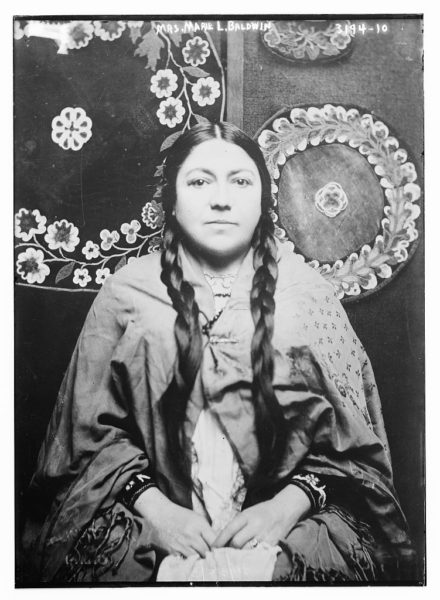 Carrie Chapman Catt returned to her role as president of the NAWSA in 1915. In 1902, she had stated “that men and women are born equally free and independent members of the human race; equally endowed with talents and intelligence, and equally entitled to the free exercise of their individual rights and liberty.” Now she was proposing a four point “Winning Plan” that asked 1) women in states where they were able to vote for U.S. President to lobby their state legislatures to send resolutions to Congress in support of a federal amendment, 2) women in states where women’s suffrage was being considered by state legislatures to work to secure it locally, 3) women suffragists across the country to advocate for universal presidential suffrage, and 4) women in Southern states to advocate for primary suffrage.
Carrie Chapman Catt returned to her role as president of the NAWSA in 1915. In 1902, she had stated “that men and women are born equally free and independent members of the human race; equally endowed with talents and intelligence, and equally entitled to the free exercise of their individual rights and liberty.” Now she was proposing a four point “Winning Plan” that asked 1) women in states where they were able to vote for U.S. President to lobby their state legislatures to send resolutions to Congress in support of a federal amendment, 2) women in states where women’s suffrage was being considered by state legislatures to work to secure it locally, 3) women suffragists across the country to advocate for universal presidential suffrage, and 4) women in Southern states to advocate for primary suffrage.
So, by 1915, after 67 years of struggle, feminists in the U.S. still had not achieved their goal of universal voting rights. It would take another 5 years of difficult and exhausting work by women at both grassroots and national levels through the NAWSA and Congressional Union (later the National Women’s Party) to push through what was often referred to as the Susan B. Anthony Amendment. Both the local and national emphases would be crucial to the passage of the amendment in 1920.
Please continue to part three of this series on the women’s suffrage movement in the United States.
UPDATE: This blog post was updated on March 15, 2024 to include a link to part three of this series and to make minor editorial changes.
Reference 1: Cooney, Robert, “Remembering Inez: The Last Campaign of Inez Milholland, Suffrage Martyr,” American Graphic Press, Half Moon Bay, CA, 2015.
Reference 2: DuBois, Ellen, “Harriot Stanton Blatch and the Winning of Woman Suffrage,” Yale University Press, New Haven, CT, 1997.
Reference 3: Alice Paul Institute, alicepaul.org.
Reference 4: “The History of the Suffrage Movement,” http://www.crusadeforthevote.org/history.
Reference 5: Lewis, Jone Johnson. “Women’s Suffrage Turning Points: 1913 – 1917,” ThoughtCo, August 27, 2020, thoughtco.com/womens-suffrage-turning-points-1913-1917-3530506.
Reference 6: “1913 Woman Suffrage Procession,” National Park Service, Department of the Interior, December 15, 2020, https://www.nps.gov/articles/woman-suffrage-procession1913.htm.
Reference 7: Library of Congress, https://www.loc.gov/collections/women-of-protest/articles-and-essays.
Reference 8: “Historical Overview of the National Woman’s Party,” Library of Congress, https://www.loc.gov/static/collections/women-of-protest/images/history.pdf.
Reference 9: Duster, Michelle, “The Women’s Suffrage Movement Included More Than Two Women and So Should the Monuments,” Essence, January 29, 2019.
Image 1: Alice Paul, photograph by Harris & Ewing, Wikimedia Commons, public domain, 1915.
Image 2: Harriot Stanton Blatch, Library of Congress via National Park Service.
Image 3: Women Suffragists in Houston, Wikimedia Commons, 1912.
Image4: Anna Howard Shaw, Wikimedia Commons, public domain, 1922.
Image 5: Lucy Burns, Vice Chairman Congressional Union, Wikimedia Commons, public domain, 1913.
Image 6: Inez Milholland, “Inez Milholland Leads the Procession,” Library of Congress, public domain, 1913.
Image 7: Ida B. Wells, Wikimedia Commons, public domain.
Image 8: Marie Louise Bottineau Baldwin, Library of Congress, public domain, circa. 1914.















Leave a Reply
Join the conversation by submitting a comment to this blog post below.